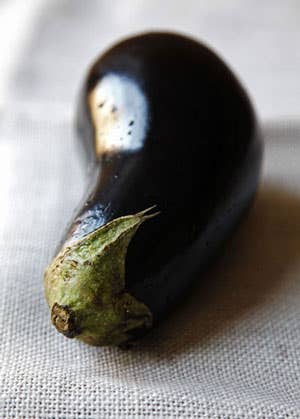
Eggplant
Eggplants come in many more shapes and sizes than the common dark purple varieties that your supermarket sells year-round. Seven different varieties of domestic eggplants can be found in most farmers' markets or gourmet food stores throughout the summer months.
The common eggplant can sometimes have an astringent flavor; its skin tends to be thick and must be peeled, and it is often full of too many seeds. Why not branch out and try some different varieties while they're around? Baby purple eggplants, also called "Indian," are about the shape and size of a chicken egg; heavily seeded with tiny seeds, this variety is very tender and sweet. Baby white eggplants, spherical and about the size of a golf ball, are also heavily seeded but are firmer, milder, and have a thicker skin. Chinese eggplants are pale purple in color, and long and thin with very few seeds. Mild in flavor, they retain their shape when cooked. Japanese eggplants also retain their shape well, though they are slightly sweeter and firmer. Thai eggplants are green, and small and round in shape. They are very heavily seeded with tasty little seeds and are sweeter and denser than other varieties, with a hint of green artichoke flavor. The white variety is very similar to the common purple eggplant, though its skin is thicker and more bitter, requiring peeling.
Eggplant must always be cooked. A common replacement for meat because of its dense taste and texture, eggplant can be grilled, pan-fried, oven-roasted, or stuffed. Puree a whole roasted eggplant to make baba ghannouj, or chop an eggplant into cubes and roast them to make ratatouille.
Featured Eggplant Recipes
Tips
- To remove any bitterness, salt sliced eggplant before cooking, then rinse and squeeze dry.
- When buying an eggplant, lift it in your hands to test for weight—the heavier the better.
- To test for ripeness, press the flesh. It should dent but spring right back.
- Use eggplants as soon as possible after purchase. They can sit for up to two days on the countertop, or be wrapped in a paper bag and stored in a warmer part of the fridge.
- To keep the vibrant color of Chinese or Japanese eggplants, dip your prepared slices or chunks into hot oil before using.
Where to Buy
Though the imported common purple eggplant is available year-round in most grocery stores, locally grown eggplants are available in many parts of the country during summer only. White eggplants are available in the earlier part of the summer; look for all other varieties at your local farmers' market throughout the season. Many varieties of eggplant are available at Melissa's Produce.
Keep Reading
Continue to Next Story










